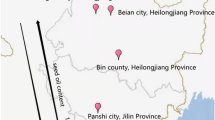Abstract
The Seeds of the fruits of some wild plants were analysed to establish their proximate compositions and the physico-chemical characteristics of the oils. The iodine values of the oils were not greater than 88 but the saponification values were in the range 157–261 mg KOH. Proximate values of the protein, oil and carbohydrate contents of the seeds suggest that they may be adequate for the formulation of animal feeds, subject to a knowledge of the levels of possible toxic substances. The Storage property of the oil fromLophira lanceolata seed were studied over a period of four weeks under conditions of light (ambient), darkness (ambient) and refrigeration. The iodine value of the oil decreased in all cases but much more so on exposure to light. In contrast, the peroxide value of the oil showed very little change under conditions of darkness and refrigeration over the same period but increased by seven fold for the photo-exposed oil.
Similar content being viewed by others
References
Eromosele IC, Eromosele CO, Kuzhhkuzha DM (1991) Evaluation on mineral elements and ascorbic acid contents in fruits of some wild plants. Plant Foods Hum Nutr 41: 151–154
Idigo MC (1989) Potential suitability of some local seed oils for paint alkyd resin synthesis. Nigerian J of Tech Education 6: 67–73
Eka OU, Isbell B (1984) Nutrient content of cotton seeds from three varieties of cotton grown in Nigeria. Nigerian J of Science 18: 76–78
Kar A, Mital HC (1981) The study of shea butter VI: the extraction of shea butter. Plant foods Hum Nutr 31: 67–69
Adesomoju AA (1987) Fatty acid composition of the seed oil ofColorophora excelsa. Bull Chem Soc Nigeria 12: 69–71
Nwadinigwe CA (1987) Chemical and toxicological studies on the seed oils ofMangifera indica L. andPersa americana, Mill. Bull Chem Soc Nigeria 12: 73–75
Passera C, Spettoli P (1981) Chemical position of papaya seeds. Plant Foods Hum Nutr 31: 77–83
Abalaka JA, Ameh DD, Adedoja FA (1989) Nutritional and industrial qualities of rubber seed oil. Nigerian J Tech Res 1: 21–24
Ukhun ME, Uwatse GM (1988) Nutritional evaluation of selected Nigerian rubber seed products — a chemical approach. Plant Foods Hum Nutr 38: 309–318
Cocks LV, Van Rede C (1966) Laboratory Handbook for Oil and Fat Analysts. London/New York: Academic Press, pp 30–37, 107–130
Bassir O (1971) Handbook of Practical Biochemistry. Ibadan: Ibadan University Press, pp 32–34
Author information
Authors and Affiliations
Rights and permissions
About this article
Cite this article
Eromosele, I.C., Eromosele, C.O. Studies on the chemical composition and physico-chemical properties of seeds of some wild plants. Plant Food Hum Nutr 43, 251–258 (1993). https://doi.org/10.1007/BF01886227
Received:
Accepted:
Issue Date:
DOI: https://doi.org/10.1007/BF01886227



